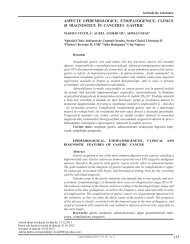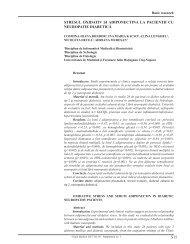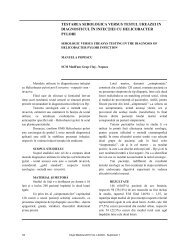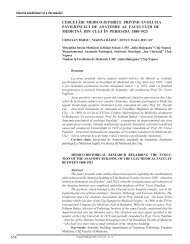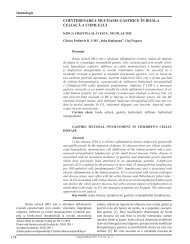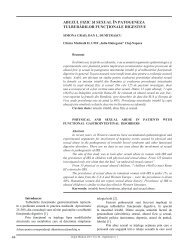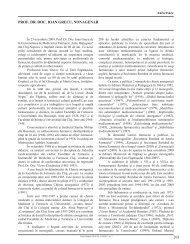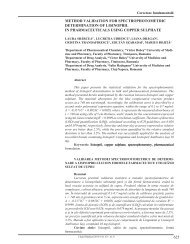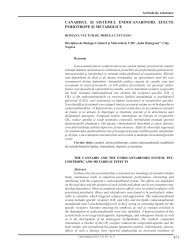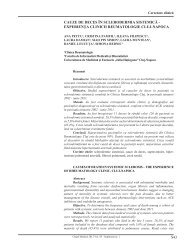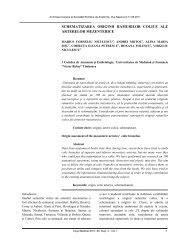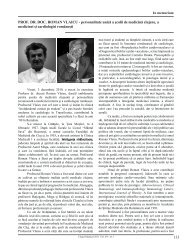RevistÄ de MedicinÄ Åi Farmacie - Clujul Medical - Iuliu HaÅ£ieganu
RevistÄ de MedicinÄ Åi Farmacie - Clujul Medical - Iuliu HaÅ£ieganu
RevistÄ de MedicinÄ Åi Farmacie - Clujul Medical - Iuliu HaÅ£ieganu
Create successful ePaper yourself
Turn your PDF publications into a flip-book with our unique Google optimized e-Paper software.
324<br />
Patologie digestivă<br />
inflamatoare cardio<strong>de</strong>presoare [20,21].<br />
Şuntul portosistemic transjugular intrahepatic<br />
(TIPS) utilizat în profilaxia hemoragiilor variceale şi în<br />
tratamentul ascitei refractare, ameliorează funcţia renală în<br />
SHR şi sca<strong>de</strong> riscul progresiei SHR <strong>de</strong> tip 2 spre SHR <strong>de</strong> tip<br />
1. Determină creşterea excreţiei urinare a sodiului, reduce<br />
activitatea plasmatică a reninei, sca<strong>de</strong> nivelul aldosteronului<br />
seric şi ameliorează perfuzia renală. Rezultate mai bune<br />
se obţin în SHR <strong>de</strong> tip 2 şi la pacienţii care au o rezervă<br />
funcţională hepatică mai bună (scor Child-Pugh mai mic).<br />
Reacţiile adverse după inserţia TIPS-ului sunt: agravarea<br />
encefalopatiei hepatice şi a insuficienţei hepatice [9].<br />
Suportul renal-hemodializa intermitentă, hemofiltrarea<br />
continuă şi MARS, se asigură pacienţilor care<br />
sunt candidaţi la transplantul hepatic. Hemofiltrarea<br />
continuă este mai bine tolerată <strong>de</strong>cât hemodializa, <strong>de</strong>oarece<br />
oferă o stabilitate cardiovasculară mai bună, realizează<br />
o corecţie gradată a hiponatriemiei cu o fluctuaţie mai<br />
redusă a presiunii intracraniene şi are avantajul în<strong>de</strong>părtării<br />
citokinelor inflamatorii (TNF-α şi IL-6).<br />
MARS-molecular adsorbent recirculating system,<br />
este o formă <strong>de</strong> dializă care utilizează un dializat <strong>de</strong><br />
albumină care este recirculat şi perfuzat pe coloane <strong>de</strong><br />
cărbune şi schimbători <strong>de</strong> anioni. Contribuie la: înlăturarea<br />
substanţelor hidrosolubile şi a toxinelor legate <strong>de</strong> albumină,<br />
reduce valoarea bilirubinei şi a creatininei, înlătură<br />
unele substanţe vasoactive care mediază modificările<br />
hemodinamice din SHR [13,15,16].<br />
Transplantul hepatic este tratamentul <strong>de</strong> elecţie<br />
al SHR. Imediat posttransplant se semnalează frecvent<br />
o <strong>de</strong>teriorare a RFG, la care contribuie şi terapia<br />
imunosupresoare cu ciclosporină sau tacrolimus.Se<br />
recomandă efectuarea transplantului înainte <strong>de</strong> apariţia<br />
SHR, fiindcă astfel creşte supravieţuirea posttransplant.<br />
Pacienţii cu SHR, care au urmat un tratament pretransplant<br />
cu vasoconstrictoare şi albumină, au o inci<strong>de</strong>nţă mai redusă<br />
a insuficienţei renale posttransplant. Supravieţuirea la<br />
3 ani este <strong>de</strong> 60% la pacienţii transplantaţi în condiţiile<br />
existenţei SHR şi <strong>de</strong> 70-80% la cei transplantaţi în absenţa<br />
SHR. Transplantul combinat ficat+rinichi se recomandă<br />
pacienţilor cu SHR care au fost supuşi unei perioa<strong>de</strong><br />
prelungite <strong>de</strong> hemodializă pretransplant.<br />
Mijloacele <strong>de</strong> tratament farmacologic, TIPS şi<br />
meto<strong>de</strong>le <strong>de</strong> epurare renală stabilizează pacientul şi permit<br />
câştigarea <strong>de</strong> timp până la efectuarea transplantului hepatic<br />
[13,15,16].<br />
Concluzie<br />
Sindromul hepatorenal reprezintă o afecţiune severă<br />
cu prognostic nefavorabil. Recunoaşterea precoce a unor<br />
modificări subtile care anunţa iminenţa SHR: hipotensiunea<br />
arterială, hiponatriemia <strong>de</strong> diluţie, scă<strong>de</strong>rea excreţiei<br />
urinare a sodiului, reducerea clearance-ului creatininic pe<br />
24 <strong>de</strong> ore, creşterea indicelui <strong>de</strong> rezistivitate al arterelor<br />
interlobare renale ar permite instituirea la timp a unor<br />
măsuri profilactice şi terapeutice ale SHR cu ameliorarea<br />
<strong>Clujul</strong> <strong>Medical</strong> 2009 Vol. LXXXII - nr. 3<br />
supravieţuirii <strong>de</strong> scurtă durată. Astfel s-ar câştiga timp până<br />
la realizarea transplantului hepatic, singura metodă curativă<br />
a pacienţilor aflaţi în această etapă.<br />
Bibliografie<br />
1. Turba S., Thuluvan P., AttA M.: Hepatorenal syndrome, W J<br />
Gastroenterol, 2007, 13, 4046-4055.<br />
2. Gines P., Guevara M., Arroyo V., J.: Hepatorenal syndrome,<br />
Lancet , 2003, 362, 1819-1822.<br />
3. Arroyo V., Guevara M., Gines P.: Hepatorenal syndrome in<br />
cirrhosis: pathogenesis and treatment. Gastroenterology, 2002,<br />
122, 1658-1676.<br />
4. Gines A., Escorsell A., Gines P., et al.: Inci<strong>de</strong>nce, predictive<br />
factors, and prognosis of the hepatorenal syndrome in cirrhosis<br />
with ascites, Gastroenterology 1993, 105: 229-236<br />
5. Genzini T., Torricelli F.: Hepatorenal syndrome: an update,<br />
Sao Paulo Med J, 2007, 125, 50-56.<br />
6. Gentilini P., Vizzuti F., Gentilini A., et al.: Ascites and<br />
hepatorenal syndrome, Eur J Gastroenterol Hepatol , 2001, 13,<br />
313-316.<br />
7. Sherlock S., Dooley J.: Ascites, In: Sherlock S., Dooley J.(eds):<br />
Diseases of the liver and biliary system, Blackwell Publishing,<br />
2002, 127-146.<br />
8. Yeung E., Yong E., Wong F.: Renal dysfunction in cirrhosis:<br />
diagnosis, treatment and prevention. Medscape General Medicine,<br />
2004, 6, 1-14.<br />
9. Wa<strong>de</strong>i H., Mai M., Ahsan N, et al.: Hepatorenal syndrome:<br />
pathophysiology and management, Clin J Am Soc Nephrol, 2006,<br />
1, 1066-1079.<br />
10. Car<strong>de</strong>nas A., Arroyo V.: Hepatorenal syndrome – pathogenesis<br />
and treatment, Curr Gastroenterol Reports, 2002, 4, 1-6.<br />
11. Dagher L., Moore K.: The hepatorenal syndrome, Gut, 2001,<br />
49, 729-737.<br />
12. Angeli P., Merkel C.: Pathogenesis and management of<br />
hepatorenal syndrome in patients with cirrhosis, J of Hepatol,<br />
2008, 48, 93-103.<br />
13. Arroyo V., Terra C., Gines P.: Advances in the pathogenesis<br />
and treatment of type-1 and type-2 hepatorenal syndrome, J of<br />
Hepatol, 2007, 46, 935-946<br />
14. Charles K., Chan M., Tai M., Lam C.: Hepatorenal Syndrome,<br />
Clin Biochem Rev, 2007, 28, 11-17<br />
15. Schepke M.: Hepatorenal syndrome: current diagnostic and<br />
therapeutic concepts, Nephrol Dial Transplant, 2007, 22, 82-84.<br />
16. Salerno F., Gerbes A., Gines P, et al.: Diagnosis, prevention<br />
and treatment of hepatorenal syndrome in cirrhosis, Gut, 2007,<br />
56, 1310-1318.<br />
17. Schepke M., Appenrodt B., Heller J., et al.: Prognostic factors<br />
for patients with cirrhosis and kidney dysfunction in the era of<br />
MELD: results of a prospective study, Liver Int, 2006, 26, 834-<br />
839.<br />
18. Kuiper J., Van Buuren H., De Man R.:Ascites in cirrhosis: a<br />
review of management and complications, The Ne<strong>de</strong>rlands J of<br />
Medicine, 2007, 65, 283-288<br />
19. Fernan<strong>de</strong>z J., Navasa M., Planas R., et al.: Primary prophylaxis<br />
of spontaneous bacterial peritonitis <strong>de</strong>lays hepatorenal syndrome<br />
and improves survival in cirrhosis, Gastroenterology, 2007, 133,<br />
818-824.<br />
20. Gines P., Guevara M.: Therapy with vasoconstrictor drugs in<br />
cirrhosis: the time has arrived, Hepatology, 2007, 46, 1685-1687.<br />
21. Lim J., Groszmann J.: Vasoconstrictor therapy for the<br />
hepatorenal syndrome, Gastroenterology, 2008, 134, 1608-1611.



